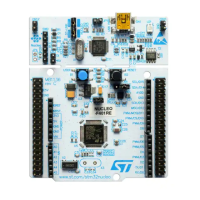RM0401 Rev 3 531/771
RM0401 Fast-mode Plus Inter-integrated circuit (FMPI2C) interface
591
• When the SCL falling edge is internally detected, a delay is inserted before sending
SDA output. This delay is
t
SDADEL
= SDADEL x t
PRESC
+ t
I2CCLK
where t
PRESC
= (PRESC+1)
x t
I2CCLK
.
T
SDADEL
impacts the hold time t
HD;DAT.
The total SDA output delay is:
t
SYNC1
+ {[SDADEL x (PRESC+1) + 1] x t
I2CCLK
}
t
SYNC1
duration depends on these parameters:
– SCL falling slope
– When enabled, input delay brought by the analog filter: t
AF(min)
< t
AF
< t
AF(max)
– When enabled, input delay brought by the digital filter: t
DNF
= DNF x t
I2CCLK
– Delay due to SCL synchronization to FMPI2CCLK clock (2 to 3 FMPI2CCLK
periods)
In order to bridge the undefined region of the SCL falling edge, the user must program
SDADEL in such a way that:
{t
f (max)
+t
HD;DAT (min)
-t
AF(min)
- [(DNF +3) x t
I2CCLK
]} / {(PRESC +1) x t
I2CCLK
} ≤ SDADEL
SDADEL ≤ {t
HD;DAT (max)
-t
AF(max)
- [(DNF+4) x t
I2CCLK
]} / {(PRESC +1) x t
I2CCLK
}
Note: t
AF(min)
/ t
AF(max)
are part of the equation only when the analog filter is enabled. Refer to
device datasheet for t
AF
values.
The maximum t
HD;DAT
can be 3.45 µs, 0.9 µs and 0.45 µs for Standard-mode, Fast-mode
and Fast-mode Plus, but must be less than the maximum of t
VD;DAT
by a transition time.
This maximum must only be met if the device does not stretch the LOW period (t
LOW
) of the
SCL signal. If the clock stretches the SCL, the data must be valid by the set-up time before
it releases the clock.
The SDA rising edge is usually the worst case, so in this case the previous equation
becomes:
SDADEL ≤ {t
VD;DAT (max)
-t
r (max)
-260 ns - [(DNF+4) x t
I2CCLK
]} / {(PRESC +1) x t
I2CCLK
}.
Note: This condition can be violated when NOSTRETCH=0, because the device stretches SCL
low to guarantee the set-up time, according to the SCLDEL value.
Refer to Table 88: I2C-SMBUS specification data setup and hold times for t
f
, t
r
, t
HD;DAT
and
t
VD;DAT
standard values.
• After t
SDADEL
delay, or after sending SDA output in case the slave had to stretch the
clock because the data was not yet written in I2C_TXDR register, SCL line is kept at
low level during the setup time. This setup time is
t
SCLDEL
= (SCLDEL+1) x t
PRESC
where
t
PRESC
= (PRESC+1) x t
I2CCLK.
t
SCLDEL
impacts the setup time t
SU;DAT .
In order to bridge the undefined region of the SDA transition (rising edge usually worst
case), the user must program SCLDEL in such a way that:
{[t
r (max)
+ t
SU;DAT (min)
] / [(PRESC+1)] x t
I2CCLK
]} - 1 <= SCLDEL
Refer to Table 88: I2C-SMBUS specification data setup and hold times for t
r
and
t
SU;DAT
standard values.

